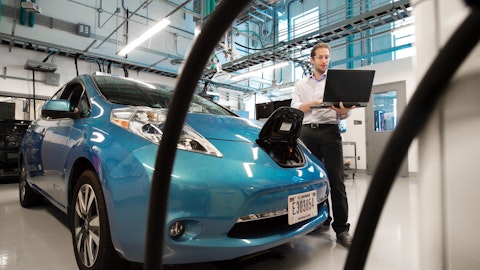Dana Incorporated (NYSE:DAN) Q3 2023 Earnings Call Transcript October 27, 2023
Dana Incorporated beats earnings expectations. Reported EPS is $0.1313, expectations were $0.1.
Operator: Good morning, and welcome to Dana Incorporated’s Third Quarter 2023 Financial Webcast and Conference Call. My name is Chris, and I’ll be your conference facilitator. Please be advised that our meeting today, both the speakers’ remarks and the Q&A session will be recorded for replay purposes. For those participants who would like to access the call from the webcast, please reference the URL on our website and sign in as a guest. There will be a question-and-answer period after the speakers’ remarks and we will take questions from the telephone only. [Operator Instructions] At this time, I would like to begin the presentation by turning the call over to Dana’s Senior Director of Investor Relations and Strategic Planning, Craig Barber. Please go ahead, Mr. Barber.
Craig Barber: Thank you, Chris and good morning everyone on the call. Thanks for joining us today for our third quarter 2023 earnings call. You will find this morning’s press release and presentation are now posted on our investor website. Today’s call is being recorded and the supporting materials are the property of Dana Incorporated. They may not be recorded copied or rebroadcast without our written consent. Allow me to remind you that today’s presentation includes forward-looking statements about our expectations for Dana’s future performance. Actual results could differ from those suggested by our comments today. Additional information about the factors that could affect future results are summarized in our Safe Harbor statement found in our public filings, including our reports with the SEC.

A driver maneuvering a large truck down an open highway, showing the transportation capabilities of the company.
On the call this morning are Jim Kamsickas, Chairman and Chief Executive Officer; and Timothy Kraus, Senior Vice President and Chief Financial Officer. My pleasure to turn the call over to Jim. Jim?
James Kamsickas: Good morning. And thank you for joining us today. First, please turn with me to page 4 where I will discuss our highlights for the third quarter of 2023. Starting on the left side, we’re pleased to report the Dana achieved robust third quarter sales of $2.7 billion, a $134 million increase over the same period last year driven by continued strong customer demand, the rollout of our new business backlogs across all of our end markets including EV programs and our ongoing cost recovery efforts. Adjusted EBITDA for the quarter was $242 million, up $50 million or 150 basis points over the third quarter of last year driven by a strong operational execution and improved efficiency. This is a tremendous accomplishment given the uncertainty the light vehicle market faced in the quarter.
Free cash flow was a use of $5 million for the quarter, which is reflective of the higher seasonal working capital requirements to support our aggressive launch scheduled this year. Lastly, our results, adjusted earnings per share for the year, were $0.30, an improvement of $0.06 per share. Dana continues to execute well across our operations despite the impact of the UAW strike on our light vehicle North America business late in the quarter. The structural profitability improvements of the business are very much the product of the entire Dana team, progressively overcoming the 2020 to 2022 onrush COVID related costs that we had endured over the past few years. As you’ve witnessed throughout the first three quarters of the year, we have systematically implemented the core tenant of our enterprise strategy, that is, what we refer to as leverage the core.
What this means is that we have driven standardization and transformational change across the entire organization. While achieving countless improvements across the business, we are especially realizing exceptional operational efficiency and customer satisfaction while simultaneously launching a company record number of new programs throughout the year. Moving to the right side of the slide, I will provide you an update on the current operating environment as well as the impact of the UAW strike, which is affecting some of our key North America light vehicle programs. Next, I will discuss the end market trends for our wide-ranging business around the world. Finally, I will provide an update on a few of the key high-profile launches that are now underway or have been completed.
Please turn with me to page five where I will walk you through an update on our operating environment. As we shared with you last quarter, we are seeing the overall operating environment improving as we go through the second half of 2023. Beginning with supply chain and currency impacts on the left side of the slide, steel prices are moderating compared with 2022, and we expect commodities to be a profit tailwind for the rest of the year. Commodity recoveries are leveling out as a result of lower input prices requiring fewer recoveries. This dynamic should continue to be a tailwind for the margin this year. As you can imagine, we have had many questions about the resiliency of the broader supply base, and we continue to closely monitor the health of our downstream suppliers.
Needless to say, the longer the UAW strike continues, the greater financial stress there will be across the tier 2 through tier 4 supply base. We are very focused on ensuring that not only are we working collaboratively through these challenging times, but that production restarts are in place and actionable once the Detroit 3 customer facilities are back online and manufacturing vehicles again. Finally, for this section, foreign currencies as translated to the U.S. dollar, particularly the euro, have become a slight headwind as the relative strength of the dollar has strengthened. Moving to the center of the slide, cost inflation is moderating, and pricing actions continue to mute the impact of inflation. As we stated last quarter, we do not expect to completely offset inflation as we close the year, but we are moving in a positive direction.
We have also seen sequential improvement in customer production volatility prior to the strike late in the quarter. In the third quarter and for the remainder of the year, we continued to successfully launch new business while systematically driving operational efficiency improvements through our integrated lean manufacturing processes and business systems. Moving to the right of the page, like everyone in the industry, our North America light vehicle business has been impacted by the UAW strike. For Dana, we have been largely affected by two of our key customers, and as of today, less than 10% of our Dana’s manufacturing plants have been significantly affected. The Dana team has done an outstanding job rapidly responding to the uncertainty of this volatile situation by idling and flexing operations as needed to mitigate the cost impact.
As a result of the strike, we saw $65 million lower sales in the third quarter. With the expansion of the strike earlier this month, we expect to see $185 million in the lower sales in the month of October. While the UAW labor disputes remain volatile, we expect benefits from operational improvements and commodity costs as we close out the year. Let’s turn to page six, where I’ll talk about the global end market trends we are seeing across our light vehicle, commercial vehicle, and off-highway markets. As we have already stated this morning, light vehicle production in North America is being impacted by the UAW strike, which has affected some of Dana’s largest and most prominent light truck programs, including Ford Super Duty, Ranger, and Bronco, as well as the Jeep Wrangler and Gladiator.
Prior to the labor disruption, production volatility levels had stabilized, and inventory levels of key programs had shown some improvement, but remained below historical levels. Demand in Europe is slightly higher due to the strong backlog of orders and restocking of inventories, while Asia production is expected to be flat. Moving to the center of the slide, in the commercial vehicle segment, we expect the overall North America Class 8 medium-duty truck market to finish the year on a high note, with the full-year production expected to be around 7% for the year, compared with 2022. In Europe, the heavy truck production outlook remains strong, with production up 15%. Meanwhile, there has been a significant downturn in South America truck and bus market at around 30% due to the overall economic slowdown.
The truck and bus market in India will be up slightly. For the off-highway market, on the far right of the slide, we anticipate infrastructure spending to support continued strong demand for construction equipment. Global agriculture equipment production is weakening a bit due to the farming commodity price decrease, while demand for mining machinery remains stable, as has been the case for most of the year. By region, North America is expected to remain stronger for the construction and agriculture equipment, while Europe shows some weakness throughout the end of the year. Asia will be slower, with China demand offsetting any growth expected in India. Overall, as we finish out the year, we see continued strong demand in our heavy vehicle markets, providing balance to the overall business.
Please turn to slide 7, where I’ll provide an update on some of Dana’s key launch programs. When we began the year, I outlined Dana’s extremely aggressive launch cadence for 2023, which has required significant capital investment and includes over 120 programs spanning both traditional and EV across all markets globally, including some very large and complex programs. We anticipate next year to be a more normalized cadence with several key launches across all segments. To date, I’m pleased to report that more than 70% of these programs are successfully completed and industrialized, including the Ford Super Duty and Ranger, as well as the Jeep Wrangler program. Once the UAW strike concludes, we anticipate these programs to be back up and running quickly as they remain some of the most sought-after vehicles in the market.
While I won’t walk you through each one on the slide, I will draw your attention to a few notable programs that are on track to launch in the next several months, including the Conquest business of the Fendt 700 Series Tractor, compact construction equipment with John Deere, and the Jeep Gladiator and Toyota Tacoma pickup trucks. All these launches spanning across all markets and regions are significant, but it’s important to note that we have successfully completed or are near completing four of our largest programs, the Ford Super Duty, the Global Ranger, the Jeep Wrangler, and the Toyota Tacoma. Together, these account for more than $2 billion in sales per year. Thank you for your time today. Now I’d like to turn it over to Tim, who will walk you through the financials.
Timothy Kraus: Thank you, Jim. Good morning. Please turn to slide nine for a look at Dana’s third quarter 2023 results. Sales were $2.67 billion, $134 million increase over last year, primarily driven by strong demand across all our segments, recoveries of cost inflation, and favorable currency translation partially offset by lower demand due to the UAW strike. Adjusted EBITDA was $242 million for a margin of 9.1%, an increase of $50 million and 150 basis points over last year’s third quarter. Our profit improvement was driven by lower net manufacturing costs, beneficial mix, and better operating efficiencies resulting from strong operational execution. Net income attributable to Dana was $19 million compared with a loss of $88 million last year.
The net loss last year was due to a non-cash goodwill impairment charge. Diluted adjusted earnings per share was $0.30, a $0.06 improvement over the third quarter of last year. Lastly, free cash flow was a use of $5 million, down $82 million from last year, driven primarily by higher working capital requirements to support our program launch cadence and higher capital spending. Please turn with me now to slide 10 for a closer look at the drivers of sales and profit change for the third quarter of 2023. Beginning on the left, traditional organic sales growth of $20 million was driven by higher demand and improved pricing, partially offset by the impact of the UAW strike on our light vehicle business. Adjusted EBITDA on higher sales was $35 million, which improved margins by 130 basis points.
Cost inflation was partially offset by customer recoveries in the quarter, resulting in net inflation headwinds of about $14 million. Improved operational execution, beneficial mix, and fewer inefficiencies driven by less volatile customer production patterns was the primary driver of profit improvement in the quarter. EV organic sales was $81 million higher than last year, and adjusted EBITDA was $12 million higher, improving overall margins by 20 basis points. Margin contribution on the higher EV sales and the deferral of engineering investment drove higher EV organic profit. Foreign currency translation increased sales by about $42 million as the dollar weakened in value against several foreign currencies, but primarily the euro. However, due to regional mix and profit was up only $2 million for a slight negative margin impact of 10 basis points.
Finally, due to falling commodity prices, commodity cost recoveries in the third quarter was $9 million lower than last year, but due to those same lower prices, there was a net profit benefit of $1 million. This resulted in a 10 basis points margin benefit. Next, I will turn to slide 11 for details of free cash flow for the third quarter. Free cash flow was a use of $5 million in the third quarter. Higher profit this quarter was offset by increased working capital requirements that were $115 million higher than last year. This was primarily driven by higher inventory requirements to support increased sales and support the large number of program launches. Capital spending was $23 million higher than last year to support our backlog of new business.
Please turn with me now to slide 12 for an update of our guidance for 2023. We have modified our guidance to account for the uncertainty surrounding the duration and scope of the UAW strike. As our base case scenario, we are assuming that the strike remains at its current scale and is resolved by the end of October. Under this assumption, we are maintaining our prior sales and profit ranges. The strike were to stretch to the end of the year, we anticipate it would lower sales by $500 million and adjusted EBITDA by $90 million. Allow me to walk you through this chart. Looking at the sales guidance range in the middle of the page, beginning at the upper end of the range on the right side of the scale, you will see that we expect sales to be $10.7 billion, assuming the strike ends at the end of October.
This is in line with our prior outlook as higher sales in our off-highway markets are expected to offset the strike impact in light vehicle. Adjusted EBITDA is expected to be about $850 million in our base case scenario as cost-saving actions and lower incentive compensation offset the strike impact on profit. Profit margin is expected to be approximately 7.5% to 8% within the range of our prior guidance. Free cash flow is expected to be a use of approximately $20 million in the base case scenario. Higher inventory and lower sales due to the strike are causing an increase in working capital. We do expect this dynamic to reduce or reverse once the strike is concluded and we are able to utilize the inventory that is both on the plant floor or in transit.
We also expect further cash flow impacts from additional supplier relief and restructuring actions. Diluted adjusted EPS remains unchanged at approximately $0.80 per share in our base case scenario. The resilience of our business to weather these external disruptions is a testament to the enterprise strategy and the ability of the team to perform in these difficult times. Thank you. I will now turn the call back over to Chris for your questions.
Operator: Thank you. [Operator Instructions] Our first question is from Noah Kaye with Oppenheimer. Your line is open.
See also 15 Best Laptops in 2023 For Students or Home Use and 11 Best Gun Stocks To Buy in 2023.
Q&A Session
Follow Dana Inc (NYSE:DAN)
Follow Dana Inc (NYSE:DAN)
Noah Kaye: Thanks for taking the questions and appreciate the range of scenarios provided. I actually want to pick up on one of Tim’s last comments. Can you speak to what you’re doing to support the health of your suppliers amid all going on over the last several weeks? How that has impacted cash conversion expectations for 4Q and what you would call out in terms of potentially that improving as we get into 2024?
Timothy Kraus: Sure. The impacts on suppliers are both related to the specific UAW actions as well as actions that have happened previously. We have one particular supplier that’s been of particular concern and we’ve been providing significant support to that supplier. So we expect to continue to have some of that into the fourth quarter. Then we will obviously do what we need to to make sure that as we go through the restart, we’re able to support the supply base and make sure we can deliver for our customers.
Noah Kaye: And just I didn’t catch it. You can possibly quantify that or dimension the impact that it’s having on cash flow?
Timothy Kraus: So the impact is in Q4. We don’t expect it to be significant, but it’s difficult to mention at this point as we know what the restart is going to be.
Noah Kaye: Okay. So the free cash flow conventions are headwinds are largely around the inventory bill that you’ve been having. Based off of the news flow that we’ve seen, it sounds like four workers for super duty, and other programs that are important to you are being asked to return. And so that may be a fairly near term event. Can you just talk about your capacity to ramp back up at some of these programs, your state of revenue and what you expect will happen as those programs start back up again?
James Kamsickas: Hey, good morning, Noah. Thanks for joining. Thanks for the question. This is Jim. I think the best way maybe to think about it is it’s, the audience is, it’s almost like the COVID shutdown timeframe. I mean, any sophisticated manufacturing company had a playbook to kind of wind it down and also had one to wind it up as part of that. It’s kind of the whole chain. Part of it’s the whole supply base and what we’re doing there, ensuring make sure that supply base has the raw material, has the labor availability, so on and so forth. Internal operations are very much within our control and making sure there that we have inventory in place. We have soft, safe launch quality programs in place because you may have some new operators or operators that have to move around to different jobs or whatever the case may be.
But from a standpoint, from our line of sight, our ability to come up will be, should not be a difficulty. We’ve ran this play before. So I hope that answers your question. But as soon as they’re ready, we’re just hopeful. It’s still a tentative, we all understand that. It’s still a tentative agreement. So hopefully we’re moving and we’re producing product back to where we were a few weeks back.
Noah Kaye: That’s helpful. Thanks, Jim. Last question from me. There’s some mixed message out of the light vehicle industry around the pace of EV investments. But of course, the majority of your programs to date have been in CV and off highway. Can you speak to the pace of EV investments and RFP activity that you’re seeing currently in those markets and your expectations for future awards activity related to electrification?
James Kamsickas: Yes. Again, thanks for the question. The way I think about it is it almost starts with when we have, I would say, a very equal balance in terms of, depending on if you put it on a revenue level of electrification wins across all of the end markets that we participate. Maybe we could dimension it differently or better in the future, but really good balance across all the end markets. So the way we’ve designed the company, most important part, when we put complete in-house electrodynamic capability across the company, it was not with one end market, i.e. light vehicle centric, or it wasn’t like one geographical market, like North America centric. It was to basically be able to scale our products, our processes, and our human capital across all of the respective end markets.
So what am I getting at here? Yes, we can see that there may be some push out in some geographical markets or maybe some push out in some end markets like vehicle, commercial vehicle, whatever. But that isn’t how we’ve designed the company. We scale our products as basically high torque, truck related products, truck and large vehicle products. So as the volume comes on, we’re able to flex with that and only go up the curve on our spending as that comes. So not too worried about that. That’s just how it works. Our light vehicle products work over in our commercial vehicle, commercial vehicle products work over in our highways, what I’m basically getting at. So in the punchline relative to new wins and so on and so forth, not here to announce anything.
We’ve sprinkled the infield, as I like to say, throughout the course of the year. At the beginning of next year in February, we’ll give you that standard backlog update and some new updates for you.
Noah Kaye: Okay, looking forward to it. Thank you.
James Kamsickas: Thank you.
Operator: The next question is from Colin Langan with Wells Fargo. Your line is open.
Colin Langan: Oh, great. Thanks for taking my questions. I appreciate the guidance. But any color on the low end, can you clarify whether that’s with Ford strike ending or is that just assuming what was happening a couple of days ago continue to the end of the year? And any color on sort of the sales drag, if it’s just GM and Solanas [Ph], how much like per week or something that, we should be kind of estimating? There is a good sort of guidepost.
James Kamsickas: Sure. Hey, Colin thanks for the question. So our low end assumes that Ford would be out through the end of the year based on, before the announcement of the tentative agreement. So it’s a fully down scenario. And if you want to think about it, right, the way to kind of dimension it, I think we’re not going to give specifics, but about half of that changes is probably Ford. The balance is everything else.
Colin Langan: And any color on like a weekly pace of the balance at this point? I mean, Ford’s over. So is it going to be 15?
James Kamsickas: All right, I think you could probably you can you can work through it. I think about the low and the high end. If it’s about a half a million dollars, half of it’s Ford. You can sort of figure out how you dimension it.
Colin Langan: Okay, all right.
James Kamsickas: And of course, it always depends on some of it depends on the restart to in terms of Ford. So, how quickly they come up and which plants come up when.



